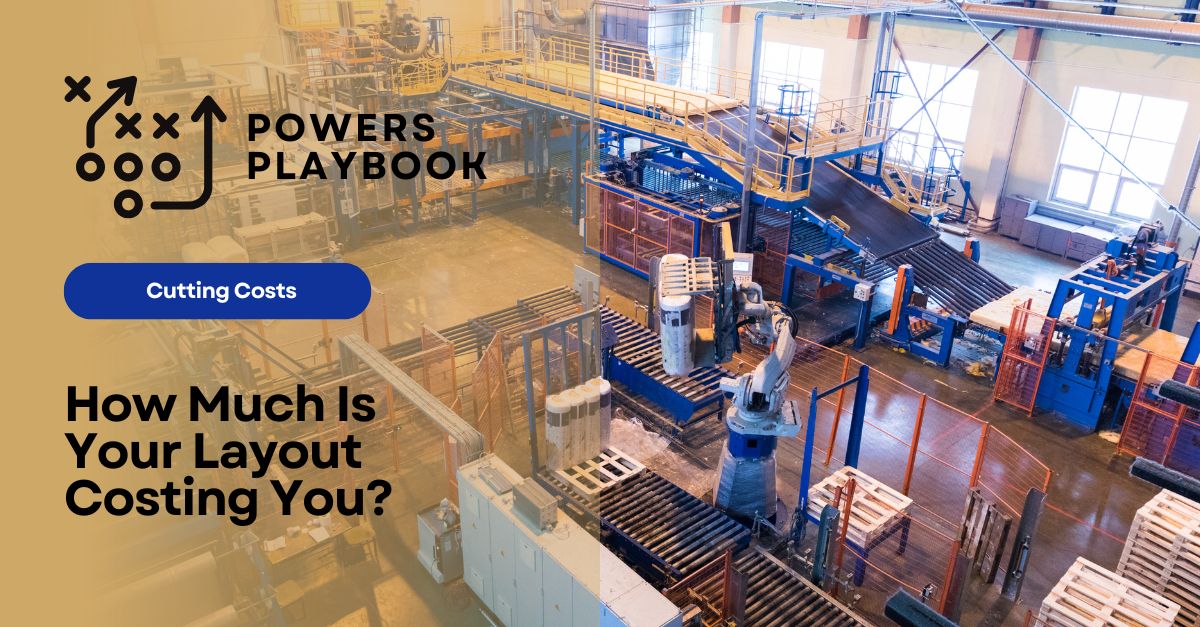
Every extra step your team takes adds up, fast.
On the floor, poor layout shows up in small ways that cost big: walking across the aisle to get a part, backtracking for a shared tool, navigating around blocked paths, or making repeated trips to the same area because there’s no clear flow.
For supervisors, these motion issues aren’t theory, they’re daily headaches. And when production’s under pressure and every second matters, movement waste slows everything down, creates frustration, and increases the chance of mistakes.
This playbook covers layout improvements you can make right now, without waiting on a full redesign or an expensive consulting project. Just practical fixes to reduce wasted movement and keep your operation running lean.
What to Watch For
Layout problems don’t always jump out. But the symptoms are easy to spot once you’re looking for them.
- Tools, raw materials, or finished parts are stored far from the point of use
- Operators have to walk around machines, pallets, or bins that block natural flow
- People from different shifts arrange the same workstation differently
- Shared resources like printers, scanners, or inspection equipment are out of the way
- Forklift routes cross with foot traffic, increasing delays and risk
- There's no consistent order to where materials move from one step to the next
Even small inefficiencies, 30 extra seconds here, a few more steps there, stack up over time. Across an entire shift, across multiple workers, across weeks or months, the impact becomes real cost.
Quick Wins You Can Put in Place Now
1Walk the Floor with Your Crew
Follow one operator through a full task. Watch what slows them down, where they stop, how many trips they take to the same place. Ask what gets in their way or what would make their day easier.
This doesn’t need to be formal. Just observe and ask questions:
- “How many times do you have to go over there during a shift?”
- “What’s something you do every day that feels like a time-waster?”
- “Is there anything you have to work around constantly?”
You’ll learn more from this 10-minute walk than a week of reviewing layout diagrams.
2Map the Actual Movement
Use a dry-erase board, chalk on the floor, or a printed layout to trace movement paths of materials, tools, and people. Do this for at least two products or tasks.
Look for:
- Repeated loops or long stretches between steps
- Crossed paths between operators or between people and forklifts
- Areas where multiple workers cluster or wait
Color-code if needed: one color for material flow, another for operator motion, and another for deliveries or support staff. This gives you a full picture of how the floor actually operates, versus how it was intended to.
3Move High-Use Items Closer
If something’s used every hour, it shouldn’t be a five-minute walk away. That’s hundreds of wasted steps a day.
Start with:
- Frequently used tools
- Small parts bins
- Cleaning supplies or measuring instruments
- Maintenance items (WD-40, Allen wrenches, etc.)
Even shifting a tool cabinet 10 feet closer can reclaim hours across a week. This applies to paperwork too, clipboards, checklists, and logbooks should be at the point of use, not tucked behind a supervisor’s desk.
4Follow the Sequence
Look at the order of operations and make sure the layout supports it.
For example:
- If Step 2 comes after welding, don’t make operators walk across the aisle just to get there.
- If packaging follows inspection, those areas should be next to each other, not separated by a forklift lane or work-in-progress pile.
Keep everything flowing forward in a straight, logical path. Fewer turns, fewer crossovers, fewer back-and-forth movements. Every extra handoff or detour increases delay and opens the door to errors.
5Use Visual Drop Zones
Operators shouldn’t have to guess where a part goes or where to pick one up.
Mark drop-off and pickup spots using:
- Colored floor tape
- Hanging signs
- Shadow boards or labeled bins
- Standard cart placements
Consistency helps speed up changeovers, reduces misplacement, and makes shift handoffs smoother. It also trains new employees faster because they’re not figuring out where things go every day.
time, reducing labor, and cutting unnecessary cost.
Bottom Line
Bad layout doesn’t just make the work harder, it makes it more expensive.
If tools are hard to reach, materials are in the wrong spot, or the line zigzags all over the place, you’re burning time that should be spent making product. And chances are, your team’s been working around these issues for months, or years.
Stop Losing Time and Money to Layout Inefficiencies
POWERS specializes in helping manufacturing teams lower costs by streamlining operations and eliminating hidden inefficiencies, like wasted movement, poor layout flow, and workarounds that drain productivity.
Our proven approach equips frontline leaders to identify waste, optimize workflows, and improve how the floor runs day to day, without increasing headcount or relying on large-scale redesigns.
To support this effort, we developed DPS to help supervisors use real-time data, reduce waste, and make fast, informed decisions using real-time performance insights DPS helps keep improvement efforts grounded in what’s really happening on the floor.
Ready to cut unnecessary costs and improve flow without adding labor or complexity?
Contact POWERS to learn how our hands-on approach and the DPS platform can help you build a more efficient, cost-effective operation, starting today.
- Speak to an Expert: Call +1 678-971-4711 to discuss your specific challenges and goals.
- Email Us: Get tailored insights by emailing info@thepowerscompany.com
- Request an Assessment: Use our online contact form, and one of our expert manufacturing consultants will reach out to schedule an in-depth analysis of your operations.

